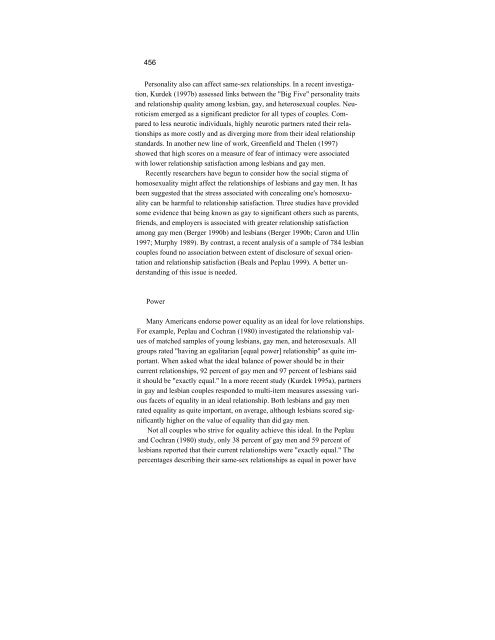17 The Close Relationships of Lesbians, Gay Men, and Bisexuals
17 The Close Relationships of Lesbians, Gay Men, and Bisexuals
17 The Close Relationships of Lesbians, Gay Men, and Bisexuals
Create successful ePaper yourself
Turn your PDF publications into a flip-book with our unique Google optimized e-Paper software.
456<br />
Personality also can affect same-sex relationships. In a recent investiga-<br />
tion, Kurdek (1997b) assessed links between the "Big Five" personality traits<br />
<strong>and</strong> relationship quality among lesbian, gay, <strong>and</strong> heterosexual couples. Neu-<br />
roticism emerged as a significant predictor for all types <strong>of</strong> couples. Com-<br />
pared to less neurotic individuals, highly neurotic partners rated their rela-<br />
tionships as more costly <strong>and</strong> as diverging more from their ideal relationship<br />
st<strong>and</strong>ards. In another new line <strong>of</strong> work, Greenfield <strong>and</strong> <strong>The</strong>len (1997)<br />
showed that high scores on a measure <strong>of</strong> fear <strong>of</strong> intimacy were associated<br />
with lower relationship satisfaction among lesbians <strong>and</strong> gay men.<br />
Recently researchers have begun to consider how the social stigma <strong>of</strong><br />
homosexuality might affect the relationships <strong>of</strong> lesbians <strong>and</strong> gay men. It has<br />
been suggested that the stress associated with concealing one's homosexu-<br />
ality can be harmful to relationship satisfaction. Three studies have provided<br />
some evidence that being known as gay to significant others such as parents,<br />
friends, <strong>and</strong> employers is associated with greater relationship satisfaction<br />
among gay men (Berger 1990b) <strong>and</strong> lesbians (Berger 1990b; Caron <strong>and</strong> Ulin<br />
1997; Murphy 1989). By contrast, a recent analysis <strong>of</strong> a sample <strong>of</strong> 784 lesbian<br />
couples found no association between extent <strong>of</strong> disclosure <strong>of</strong> sexual orien-<br />
tation <strong>and</strong> relationship satisfaction (Beals <strong>and</strong> Peplau 1999). A better un-<br />
derst<strong>and</strong>ing <strong>of</strong> this issue is needed.<br />
Power<br />
Many Americans endorse power equality as an ideal for love relationships.<br />
For example, Peplau <strong>and</strong> Cochran (1980) investigated the relationship val-<br />
ues <strong>of</strong> matched samples <strong>of</strong> young lesbians, gay men, <strong>and</strong> heterosexuals. All<br />
groups rated "having an egalitarian [equal power] relationship" as quite im-<br />
portant. When asked what the ideal balance <strong>of</strong> power should be in their<br />
current relationships, 92 percent <strong>of</strong> gay men <strong>and</strong> 97 percent <strong>of</strong> lesbians said<br />
it should be "exactly equal." In a more recent study (Kurdek 1995a), partners<br />
in gay <strong>and</strong> lesbian couples responded to multi-item measures assessing vari-<br />
ous facets <strong>of</strong> equality in an ideal relationship. Both lesbians <strong>and</strong> gay men<br />
rated equality as quite important, on average, although lesbians scored sig-<br />
nificantly higher on the value <strong>of</strong> equality than did gay men.<br />
Not all couples who strive for equality achieve this ideal. In the Peplau<br />
<strong>and</strong> Cochran (1980) study, only 38 percent <strong>of</strong> gay men <strong>and</strong> 59 percent <strong>of</strong><br />
lesbians reported that their current relationships were "exactly equal." <strong>The</strong><br />
percentages describing their same-sex relationships as equal in power have
















